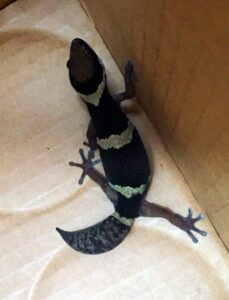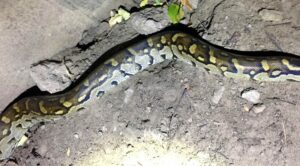It’s the end of June and we are experiencing typical winter weather here. This really only lasts for the months of June and July. At night the temperature is getting down to around 9 degrees Celsius, but by lunchtime, it’s back to 25 or 26. The skies are almost cloudless and our guests have taken to lying out on their decks in the mornings to soak up the warmth.
I think the river water must be very cold because we are sometimes seeing up to three hippos out of the water lying on the sand around this area and soaking up the sun. I woke this guy up as I went past in my boat this morning and he glared at me rather menacingly.
The Zambezi continues to recede; at the upstream measuring station at Chavuma, where the river crosses back into Zambia from Angola, the level is at its lowest level for 50 years. Here, at The Big Tree, the volume is recorded as 896 cubic meters/second – 32% of the level recorded at the same time last year.
Two weeks ago, I unpacked a box of South African wine which had come from our stores at the big lodge. Inside the box, I found one of the most beautiful geckos I have ever seen. I lived at Sossusvlei in Namibia for two and a half years some time back and learnt a bit about these fascinating little creatures.
The late Dr Bill Branch was herpetologist in charge of the Port Elizabeth Museum at the time, and he used to travel throughout Namibia on collecting expeditions. He always stayed with us at the lodge I was running at the time. The only gecko roughly matching this one’s description in the reptile book for Southern Africa was Pachydactylus Goodi, but they are only found in the North-Western Cape Province of South Africa, a very long way from here.
I found Dr Jiri Smid on the internet, after much searching. He works in the department of zoology in Prague, Czech Republic. I sent him photos of the gecko and received this reply, which just deepens the mystery:

“It really is a curious gecko! At first, I thought it to be a Hemidactylus Fasciatus, which is a Central African species typical for its thick bands across the body. But then I took a second look and the toe tips and body shape really look like that of a Pachydactylus. I browsed through the South African Reptile Atlas and it quite resembles P. Tigrinus. But given its completely unknown origin, I am not really sure. Do you want me to pass it on to people who might have a clue?
Cheers
Jiri Smid”
I have not heard back from Jiri and I have not seen the gecko again, which saddens me. Was he a reluctant stowaway in the wine box, or is there an undescribed species of gecko here on our little island? Bill Branch told me that new species of geckos are being discovered every year in this part of the world, which is astonishing.

On the way home from the Island bar at about 8.00pm last week, I found a beautiful Southern African python on my path. I estimated his length to be about two meters, and because they can get to six meters, I assume that he was relatively young. He was calmly drinking from a leaky tap next to the linen store. 99% of people on safari in Africa never lay eyes on a snake whilst here, which is funny given that most of them profess to be terrified of snakes. I asked our guests if they wanted to come and see him, and some would not even leave their tables.
Snakes have few friends in Africa, but pythons really are beautiful, useful to humans, and harmless too. They are excellent swimmers and I suspect we might be fortunate to have a number of them about on the island.


